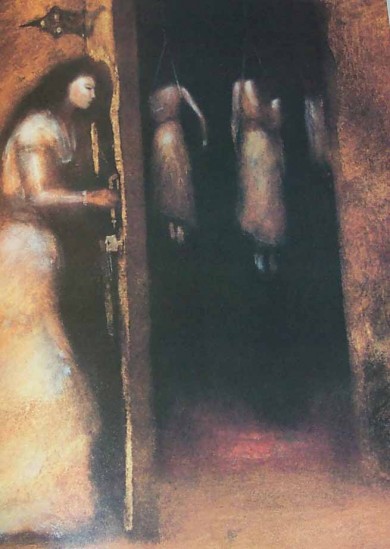FAU’s minimalist “Bluebeard’s Castle” puts across Bartok’s opera with maximum impact

"Bluebeard's Secret Chamber," painting by Matt Mahurin.
The Florida Atlantic University Department of Music presented an ambitious production of Bela Bartok’s one-act opera Duke Bluebeard’s Castle before an enthusiastic audience Sunday afternoon at the University Theater on the Boca Raton campus. Composed in 1911, the opera is an expressionist psychological drama, a battle of wills and nerves between the notorious murderer Bluebeard and his bride Judith.
Bartok’s score is one of his richest, most original creations, based on the rhythms and patterns of the Hungarian language. Folk music, polytonality and the striking use of the minor second as the blood motif highlight a work of bold harmonic and dramatic construction.
The two-character piece revolves around Judith’s arrival at Duke Bluebeard’s castle and her insistence that he open seven locked doors to bring air and sunlight into the dark, gloomy fortress. At first he refuses, asking only for Judith’s love. She has heard rumors about the possible sinister disappearance of his previous wives and demands to see what is behind the doors.
Gradually he relents, handing her the keys to the first five doors. Behind them she finds a torture chamber, an armory, his jewels, the garden and his vast estate. Judith is alarmed to see blood inside each. Although Bluebeard begs her not to open the final two doors, she becomes ever more agitated and insistent. When she finally opens them, Judith sees a lake of tears and his previous wives. She finally enters the seventh door to join them.
Bartok and his librettist Bela Balazs left much to the viewer’s imagination and the FAU production capitalized on that element. Jim McDonough conceived sets and lighting in a Wieland Wagner-like minimalist style. A sculpture that served as the door to the castle, then changed shape subtly as it became each of the locked doors, was the main scenic element on a largely bare stage. Spotlighting on the principles and subtle lighting hues helped define the characters’ emotions.
Veteran bass Dean Peterson was a superb Bluebeard. Not a stock operatic villain or Hollywood serial killer, Peterson played the Duke as regal yet troubled and definitely in love with Judith. He became ever more desolate at her relentless insistence to know his secrets. Peterson brought aching sadness to Bluebeard’s final line “There will always be night here” as darkness engulfed the stage. With credits that include the Met, La Scala and the Vienna State Opera, Peterson combines a powerful stage presence with a mellifluous bass voice of expressive power and depth. His dulcet soft tones were haunting in the best interplay of music and dramatic inflection.
Soprano Birgit Fioravante was a glamorous but fiercely determined Judith. Fioravante has improved greatly since her years with Florida Grand Opera in the 1990s. She is a true theatrical animal who commands the stage. Her large voice and sweeping sense of line were most impressive in the Straussian love music of the garden scene, sung with rapturous intensity.
Still, there is harshness in her top range and a wide vibrato afflicts her singing at times. Judith’s quasi mad scene as she demands to open the seventh door was consistently shrill and unwieldy but Fioravante succeeded in making her a three-dimensional figure and a worthy match for Bluebeard.
Musical director Krisztina Kover, who also acted as Hungarian diction coach, was a tower of strength at the keyboard. Kover utilized a skillful reduction of the score for piano and keyboard synthesizer, sharing the orchestra pit with the equally hard-working Katherine Kozak. Still, this transcription could only hint at the instrumental color and harmonic adventurousness of Bartok’s full score.
A full scale production of Bluebeard’s Castle with orchestra is long overdue in South Florida. Many orchestras have produced concert versions (most recently the Boston Symphony and the New York Philharmonic). This score would be a perfect vehicle for the New World Symphony in its outstanding new concert hall.
Still, kudos are in order to the music division of FAU for staging this twentieth-century masterpiece and fielding a group of dedicated musical and theatrical artists who brought experience, conviction and theatrical savvy to this seminal work.
Posted in Performances
Leave a Comment
Mon Mar 21, 2011
at 4:22 pm
No Comments






